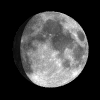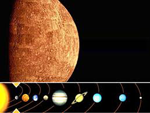Courtesy of EarthSky
A Clear Voice for Science
www.EarthSky.org

 Comet Hartley 2 might brighten to binocular object by late September 2010
Comet Hartley 2 might brighten to binocular object by late September 2010
Our sky chart shows the eastern sky for about one hour before sunrise at our mid-northern latitudes. If it is clear, there is a good chance that you will spot Mercury – the solar system’s innermost planet – sneaking onto the stage of sky. However, to catch this elusive world, you will need a level, unobstructed horizon in the direction of sunrise.
Mercury stands farthest west of the sun tomorrow, so it rises a maximum time before sunrise. At our mid-northern latitudes, that is about 1.5 hours before the sun. Still, it will take a deliberate effort to catch this world. It is with good reason that the ancients regarded Mercury as the god of thieves. Like a thief, this world hides behind obstructions, such as trees or buildings.
Looking for a sky almanac? EarthSky recommends
 Timing is essential for catching Mercury. If you look too soon, Mercury will still lurk beneath the horizon. If you look too late, it will disappear in the sun’s glare. Try looking 75 minutes to 45 minutes before sunrise. If you are up before dawn, use the bright star Regulus as your guide to Mercury. This star rises some 40 to 45 minutes before Mercury does.
Timing is essential for catching Mercury. If you look too soon, Mercury will still lurk beneath the horizon. If you look too late, it will disappear in the sun’s glare. Try looking 75 minutes to 45 minutes before sunrise. If you are up before dawn, use the bright star Regulus as your guide to Mercury. This star rises some 40 to 45 minutes before Mercury does.
For the northern hemisphere, this whole next week will stage Mercury’s best morning apparition until January 2011. If you have binoculars, be sure to grab them. They help immeasurably with any Mercury quest. Although Mercury shines as brightly as a first-magnitude star, the encroaching morning twilight will subdue the luster of September’s morning “star.”
Much brighter point of light in southeast to southern sky:
Sky trick: Orion’s belt points toward Sirius
Written by Bruce McClure
Astronomy Picture of the Day from NASA/JPL
U.S. Naval Observator Astronomical Information center
The York County Astronomical Society